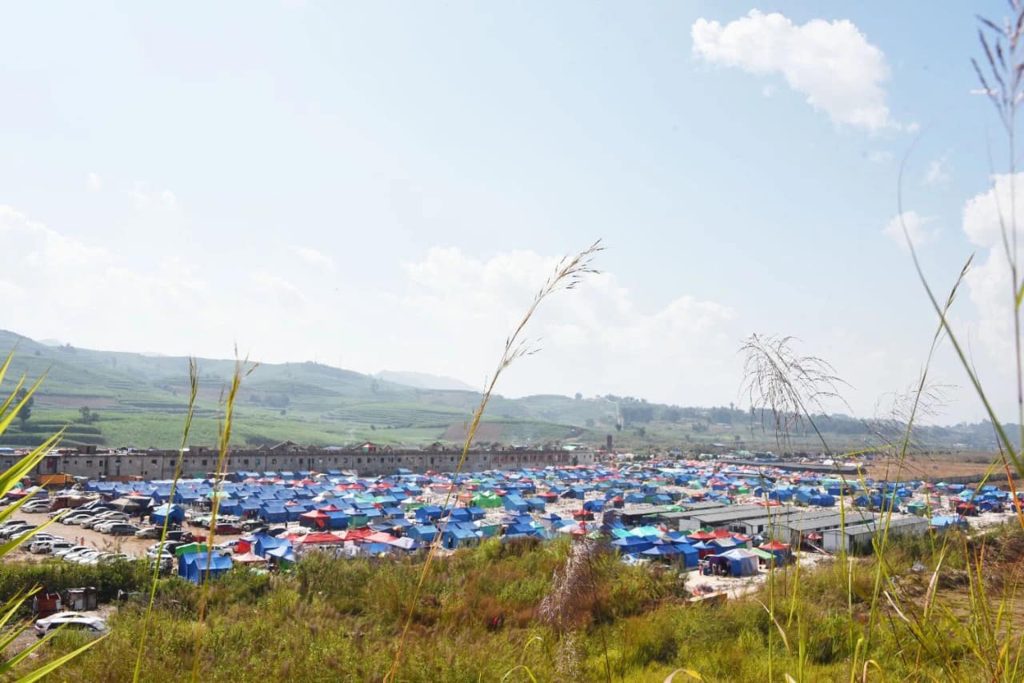Insight Email No. 27
This Insight Email is published on November 14, 2023, as a translation of the original Burmese language version that ISP-Myanmar sent out to the ISP Gabyin members on November 10, 2023.
Recent news has been dominated by the Three Brotherhood Alliance’s (3BHA) ‘Operation 1027’ fighting in northern Shan State. ISP-Myanmar plans to make a series of three OnPoint reports on the topic. This week we discuss the contextual background of the ‘Operation 1027’ and its ‘signaling effects’. As the war rages in northern Shan State, more than 15,000 people have reportedly had to seek refuge in the refugee camp near border post 125 (BP 125) situated on the Myanmar-China borderline in Kokang Region. Meanwhile, the State Administration Council (SAC) chairman has pushed to materialize the opening of the Kyaukphyu Special Economic Zone (SEZ) which is directly linked to Chinese interests. In addition, this bulletin discusses the first Myanmar-Russia joint-naval exercise, and the Karen National Union’s (KNU) first ‘Karen Socio-Economic Household Survey’.
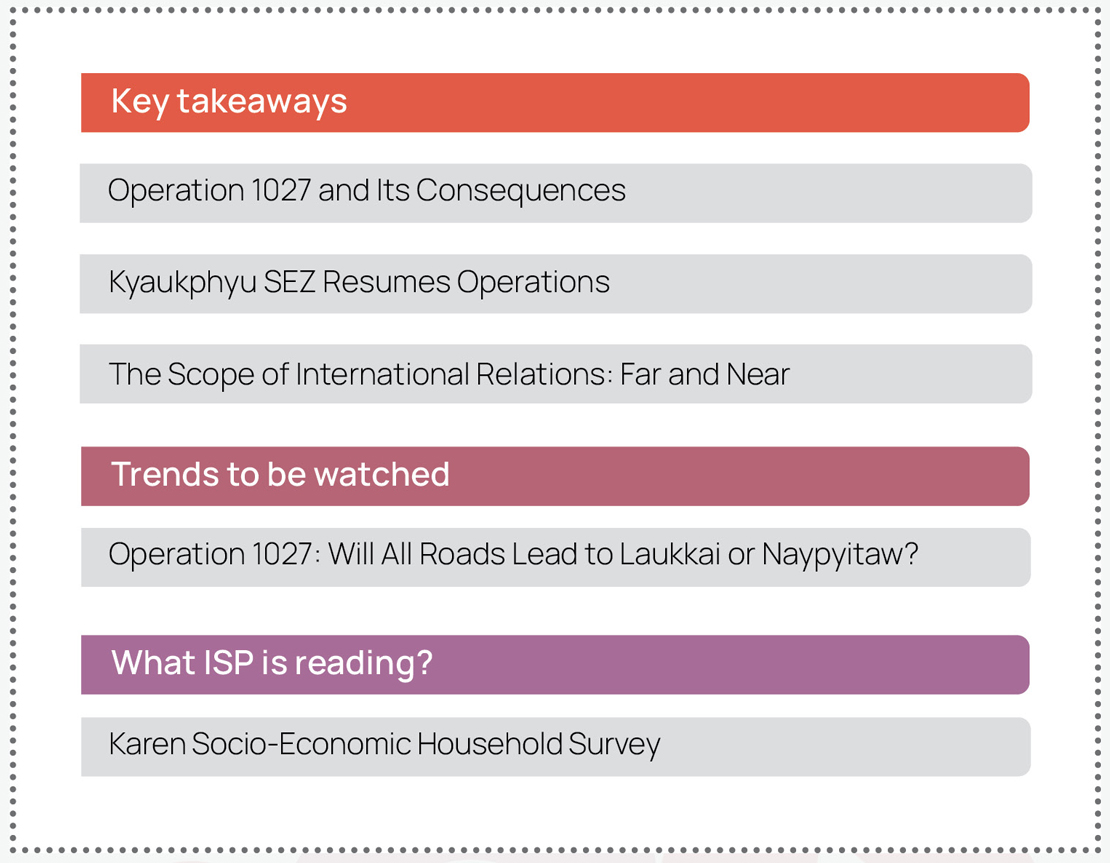
∎ Key takeaways
1.Operation 1027 and Its Consequences
Recent news has been dominated by the three Brotherhood Alliance’s (3BHA) ‘Operation 1027’ fighting in northern Shan State. ISP-Myanmar plans to make a series of three OnPoint reports on the topic and for this week, we discuss the contextual background of the war and its ‘signaling effects.’ Please find the first report in the chapter ‘Trends to be watched.’ In the second report, ISP plans to report on the economic factors embedded within the war, and finally, the third report will discuss how the unfolding scenario could impact Myanmar’s future landscape.
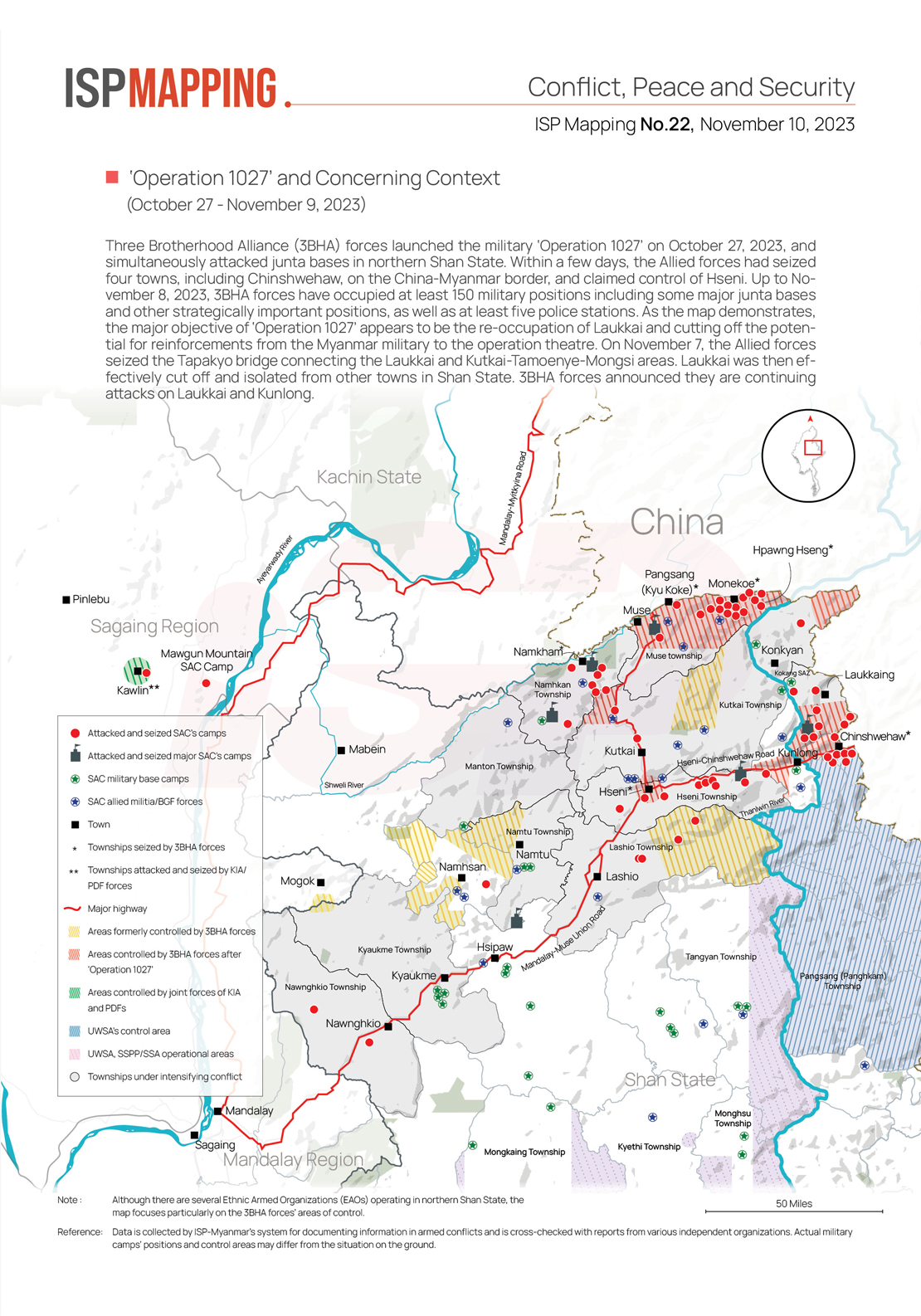
2.Kyaukphyu SEZ Resumes Operations
While ‘Operation 1027’ rages in northern Shan State, the SAC chairman has rushed to materialize the Kyaukphyu SEZ, which is directly linked with Chinese interests. The leaders of the Rakhine State government, where Kyaukphyu is located, then called a meeting with SAC government officials on November 3 to discuss issues of immediate concern, including appropriation of lands for the project. On November 7, the SAC’s Commerce Ministry announced the establishment of the ‘Myanmar Government Designated Entity Consortium’, inviting private sector investment. Prospective consortium members must adhere to the 2017 Company Act, demonstrate a decade of operational history, have generated a minimum revenue of USD 20 million in the past three years, and possess the necessary skilled workforce, capital, and resources. Members of the consortium are eligible to invest from a starting amount of USD five million.
Establishing an SEZ requires a huge amount of foreign investment combined with a lot of preparation from the host country in order to advance its strategic interests. Over the past decade, Dawei SEZ in Southern Myanmar had been touted for success, but was later suspended after being unable to attract credible foreign investment. The Kyaukphyu SEZ project is located on 240 hectares of the Maday and Ramree islands and was expected to cost USD 1.3 billion. These projects would be impossible relying solely on local investment levels. However, the willingness of Chinese capital to take greater risks abroad makes the Kyaukphyu SEZ project feasible with Chinese interest. However locals are primarily concerned with land-use rights and the potential for unfair land confiscation, as well as wider negative socio-and environmental impacts.

3.The Scope of International Relations: Far and Near
On November 7-9, 2023, the first-ever Myanmar-Russia Maritime Security Exercise (MARUMEX) was convened in the Myanmar Sea. For the naval exercise, three Russian Navy destroyers arrived in Myanmar, led by Captain 1st Rank Aleksei Anciferov of the Russian Navy’s Pacific Fleet. The sea, air, and undersea exercises were conducted in the Mergui archipelago (85 nautical miles west of Myeik). Russia’s Navy Chief, Admiral Nicolai A. Yevmenov visited Myanmar along with the fleet. The Myanmar Navy claims to have developed into a ‘Three-dimensional Combat-ready Navy’ and intends to grow to become an ‘Adjacent Force Projection Navy or Regional Navy’. Closer diplomatic ties with Russia have been observed since the military coup in 2021.
Conversely, the United States has imposed a new round of economic sanctions on the Myanmar junta. In a statement from the U.S. Department of Treasury on October 31, the sanctions against the state-run Myanmar Oil and Gas Enterprise (MOGE) applied from December 15 mean that US citizens will be prohibited from conducting “certain financial services” that benefit the company, with the intention to block a key source of income to the junta. The United Kingdom and Canada will also coordinate themselves to comply with this act, reports said. The U.S. sanctions also directly targeted individuals including Chief of the General Staff (Army, Navy and Air) Gen. Maung Maung Aye, Industry Minister; Charlie Than, Investment Minister; Kan Zaw, as well as some other businessmen. The immediate impacts of the sanctions on the Myanmar junta would be limited but the sanctions will force the junta to embark on a difficult process to evade the sanctions. Meanwhile, India granted and signed an MoU for three ‘Quick Impact Projects’ (QIPs) for Myanmar on November 6, including a water supply project in the dry zone, an electronic library system for government departments, and a small-scale wind turbine for electricity generation.
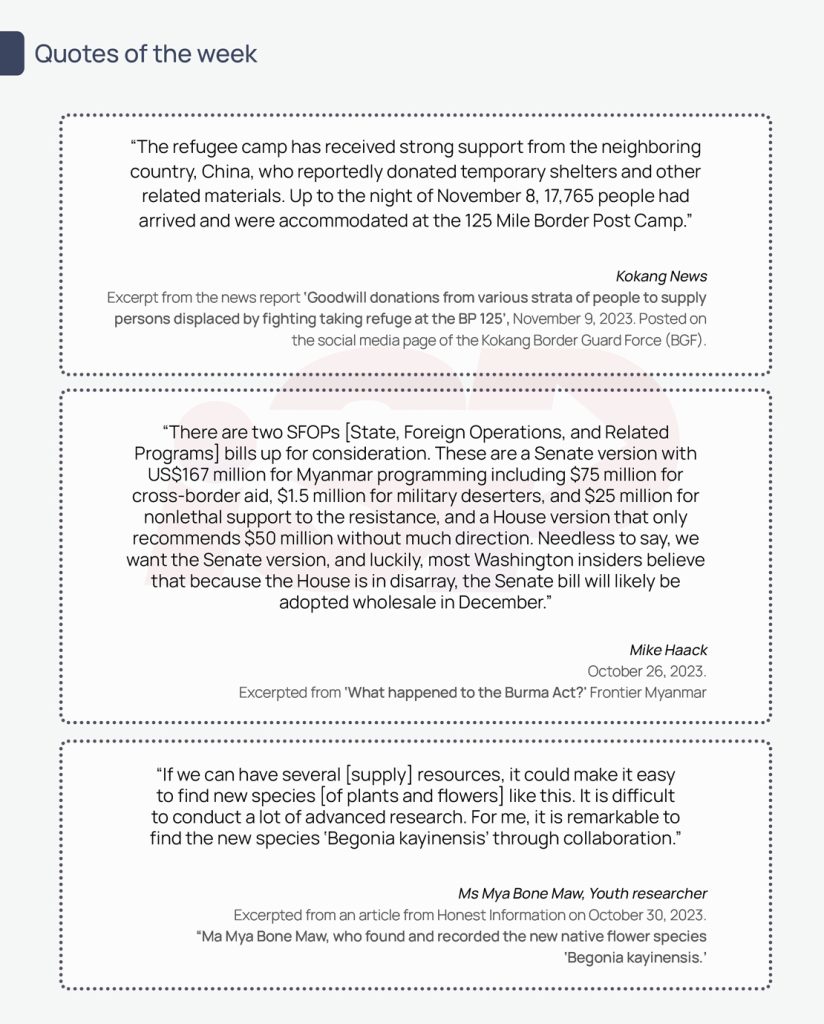
∎ Trends to be watched
‘Operation 1027’: Will All Roads Lead to Laukkai or Naypyitaw?
This section is re-printed from ISP-Myanmar’s OnPoint published on November 10, 2023.
∎ Events
On October 27, 2023, the three Brotherhood Alliance (3BHA), namely the Myanmar National Democratic Alliance Army (MNDAA), the Ta’ang National Liberation Army (TNLA), and the Arakan Army (AA), along with other allied forces launched the military ‘Operation 1027’1. Within a few days, the initial phase of the operation resulted in effective 3BHA control of five towns along the China-Myanmar border including the Chinshwehaw border checkpoint. By November 8, the 3BHA’s forces had seized more than 150 military camps including some strategic positions and base camps, along with at least five police stations. 3BHA and allied forces reportedly seized six tanks, four military trucks, two howitzers, and a large stock of ammunition and weapons from State Administration Council. Tatmadaw Infantry Battalion No 143 based in Kunlong surrendered to 3BHA and allied forces amidst heavy fighting. The resistance forces seized two important bridges and effectively cut off national highway access to the region. A 3BHA statement lists the military objectives of ‘Operation 1027’ as combatting widespread online fraud and gambling, asserting their right to self-defense, maintaining control over their territory, and ultimately eradicating oppressive junta military rule.
∎ Preliminary analysis
Recent conflict history in northern Shan State has shown that significant shifts often occur rapidly when China’s interests in Myanmar reach a pivotal point. Conflict actors in Myanmar, whether they are state or non-state actors vying for complete or partial power, can capitalize on this opportune moment by acting decisively. Essentially, the key is for Myanmar conflict actors to take action when China’s interest in Myanmar is at its peak.
To demonstrate, in 1988-89, when Kokang and Wa ethnic armed forces rebelled against the leadership of the Communist Party of Burma (CPB), Deng Xiaoping’s China, which had been recently successful with reforming towards a market-based economy system and experimental opening to international trade, reversing their previous patronage with the CPB leadership. The person who most effectively seized the moment of this watershed opportunity presented by China’s backflip was the intelligence chief of the former junta, State Law and Order Restoration Council (SLORC), Brig. Gen. Khin Nyunt. At this critical juncture. Khin Nyunt made a groundbreaking proposition to the Kokang and Wa forces—an unprecedented move in Myanmar’s history. He made a proposal to the armed groups in northern Myanmar, that they be permitted to continue to hold their weapons but enter into ceasefire, collaborating with the junta for regional development, and that in return they would be permitted to engage in any business activities they liked to raise revenue, whether that be illicit drug trafficking or money laundering, they would be free from interference from the ruling junta. This new ceasefire initiative of the military intelligence developed into an institutionalized ‘ceasefire crony capitalism’ in the period that followed. This new attempt at a form of ceasefire changed the landscape of conflict not only in northern Myanmar but also across the whole nation.
The rapid growth of the Arakan Army (AA) can also be understood through this ‘China opportunity’ lens. After Myanmar’s 2010-11 political transition, the hybrid civilian government in September 2011 unexpectedly suspended billions of dollars worth of Chinese investment dam project at the Myitkyina site at the Ayeyarwaddy River confluence in Kachin State. More importantly, China’s concerns grew as U Thein Sein’s administration became more friendly with various Western governments. China had previously been pursuing deep strategic interests with Myanmar, particularly through the Kyauk Phyu deep-water seaport, which also included a Special Economic Zone (SEZ), as a form of Chinese access to the Indian Ocean, as well as China’s oil and gas pipeline which passes through Rakhine State to inland China’s Yunnan Province. China could probably foresee strategic opportunities northern Shan State and in Rakhine State, not only to expand its economic interests but also to expand its state reach in order to guarantee security to its projects. The conflict actor who took advantage of this situation was Gen. Twan Mrat Naing, chief of the Arakan Army (AA). When the AA was founded in 2009, its force numbered only 29 men, but after the event of suspension of the Myitsone Dam project in 2011, and after relocating their major forces into Rakhine State in 2014, the AA subsequently strengthened and its numbers swelled to several thousand troops. The AA has since become the second-largest ethnic armed organization (EAO) after the UWSA.
In analyzing ‘Operation 1027,’ the Kokang forces and their allies, and specifically the three Brotherhood Alliance, have effectively mobilized themselves and embarked upon a mission-centric objective which does align with China’s own concerns over the eradication of ‘Kyar Phyant’ (诈骗)– online fraud, and gambling. China’s rhetorical intolerance towards cyber-scams, which have victimised thousands of its citizens, is a driving force behind China’s agenda. Within Chinese society, the issue of online scams and slavery within illicit border-zone cartels gained prominence immediately after the release of the blockbuster film ‘No More Bets.’ Chinese citizens’ concerns and criticism created a hot issue for Chinese authorities. While Chinese officials have raised the issue seriously with the Myanmar junta many times, the junta has seemingly been either inattentive or has treated the problem lightly. Moreover, Chinese authorities have given time to Bai Xuoqiang of the Kokang Self-Administered Zone, however no results have materialized. Worse still, up to October 20, 2023, reportedly about 60 Chinese citizens have been killed in the Kokang area, including undercover Chinese police. Bai Xuoqiang has seemingly defied Chinese warnings, by emphasizing his association with the SAC Chief in political and business matters. This is tantamount to Bai challenging China’s attempts to impose pressure on the Kokang leader.
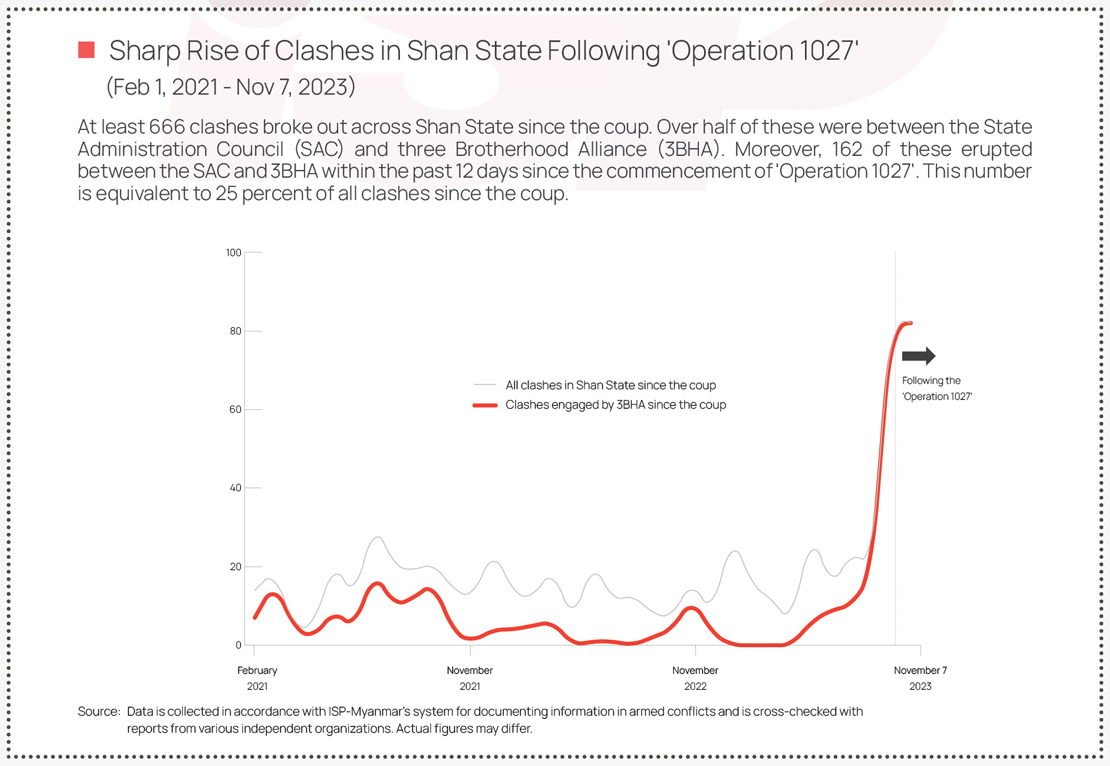
In terms of the Wa region, China is seemingly disgruntled with the rise of new generational leadership in the UWSP, as these new leaders seem more nationalistically inclined. China may feel that the new Wa leadership might become less open to listening to China’s perspectives and wishes in the region. This could be the main reason behind why Chinese authorities themselves have become involved in extra-territorial arrests of Kokang, and some Wa, leaders, and issuing warrants against those who are alleged to have committed criminal activities under Chinese law. These arrests aimed to shake up Wa’s leadership under the claim of their involvement in the Kyar Phyant online gambling industry. China appears to selectively target only Kokang and Wa leaders, while appearing satisfied with Mong La leaders, suggesting reliance on Mong La. In a broader perspective, while Kyar Phyant is now an immediate issue in northern Myanmar, the longer-term horizon, raises a hypothesized scenario in which China is actively engaged in reconfiguring its power projection capabilities in the area. The immediate focus on Kyar Phyant could be a strategy to address multiple concerns simultaneously. To comprehend the interplay between China’s short-term and long-term strategies in northern Myanmar, attention must be directed not only to security matters but also to the intertwining economic interests of China in the region. (The upcoming ISP-Myanmar OnPoint No. 18 will discuss these economic linkages).
A more thorough analysis of the assumption of China’s role in internal power reconfigurations in northern Shan State could consider the following scenarios and projections: 1) China may intend to replace the present Kokang leader Bai Xuoqiang with new leadership; 2) China may send a ‘Do and Do Not’ message to the UWSA leadership, using the immediate issue of Kyar Phyant online gambling against the background context of rising Wa nationalism; and finally, 3) China could strengthen its interests east of the Salween River, by reinforcing demographic (ethnic population ratios) and economic power. In conclusion, the ongoing ‘Operation 1027’ in Kokang is a convergence of China’s interests and the MNDAA’s goal of reclaiming control over Laukkai. The strategic aim of the operation may involve reoccupying Laukkai as a base, while the stated objective of ‘eradicating the oppressive military rule in Myanmar’ could serve as a tactical agenda—a shrewd preemptive measure to garner popular support.
China may provide a ‘green light’ to ‘Operation 1027’, but it should be noted that conflict actors in Myanmar are not so passive or subjective as to act on signals from China. Myanmar actors have consistently demonstrated their own agency, and that they can reinvent their positions within the given situation to maximize their strategic options, from the strategic management of Khin Nyunt in 1989, to the strategic-sophisticated Twan Mrat Naing of the AA after 2011, to the recent military maneuvers of the 3BHA. History has demonstrated that these forces have the ability to seize opportunities, remold their positions to achieve more favorable conditions and that they are more than capable of producing results on their own terms.
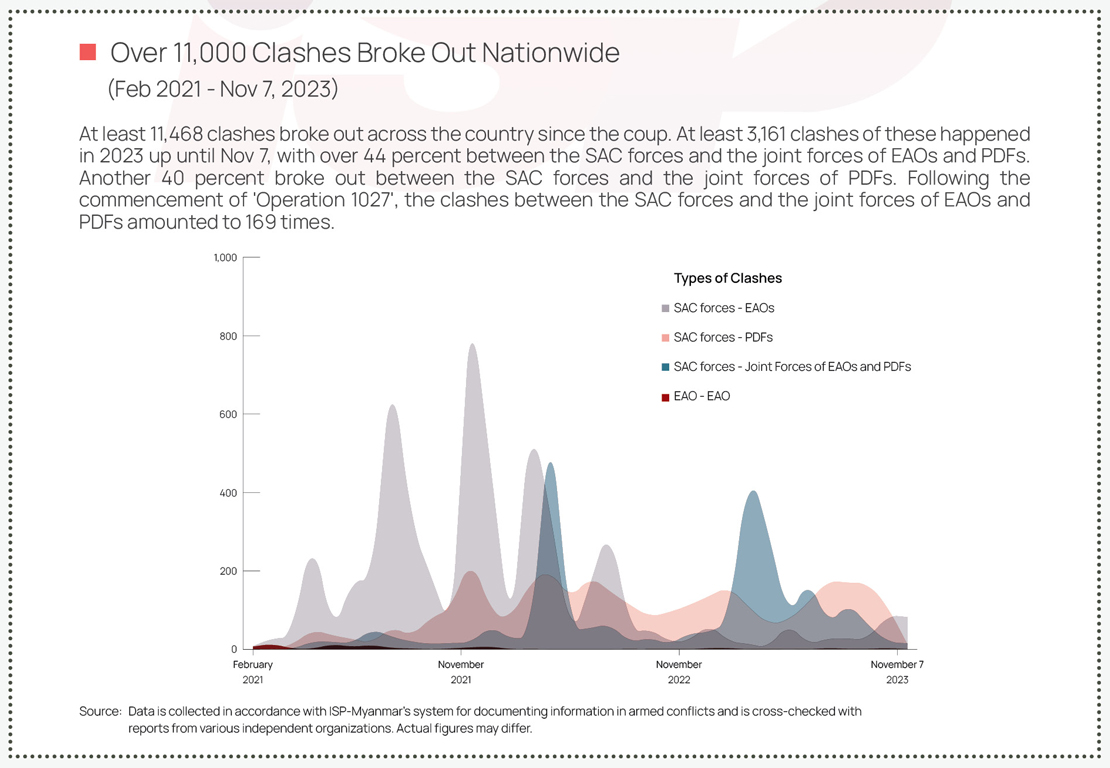
While conflicts as part of the current ‘Operation 1027’ have been raging broadly in at least eleven townships, the main target of the operation remains the re-occupation of Laukkai, while other battles’ objectives are to cut off supplies and reinforcements to the Myanmar military (Please see ISP Mapping No. 22).
∎ Scenario forecast
How can we initially assess whether ‘Operation 1027’ will expand its scope in terms of objectives, tactics, and ambition? Could the offensive ultimately lead all the way to Naypyitaw, as the opposition National Unity Government (NUG) has claimed? To engage with these aspects and more, we should analyze the ‘signaling effects’ of the ongoing operation.
Firstly, what signal is the ‘Operation 1027’ offensive sending to the Myanmar military? The success of the operation demonstrates Myanmar’s military weakness and loss of popular support in northern Shan State. The Tatmadaw may be materially superior to the resistance forces, but is facing intelligence and security failure at the same time losing the will to fight. ‘Operation 1027’ also signals that top Tatmadaw leadership lacks suitable withdrawal options for regular troops caught up in this crisis. Considering external pressures, ‘Operation 1027’ calls into question whether the junta military might face internal implosion depending on whether the theatre of war can expand beyond northern Shan State.
Secondly, 3BHA’s ‘Operation 1027’ offensive sends strong signals to other armed resistance groups on the capabilities of the junta’s state power. These other resistance forces can then make their own assessments on whether the Tatmadaw is in a vulnerable position or not, and whether they can risk entering into an all-out war or not. These third-party armed resistance forces can for now stay uninvolved in the conflict while assessing the cost-effectiveness of joining the fray. It can already be observed that other armed resistance groups in Sagaing Region, including the KIA, NUG’s PDFs, and local defense forces (LDF) have already begun launching simultaneous attacks, and that resistance groups from Karenni are also coordinating attacks under the codename ‘Operation 1107.’ However the Arakan Army (AA), one of the three constituent 3BHA forces, is still holding to an informal ceasefire in its home Rakhine State and is reluctant to join the all-out fight.2 Future expansion of the war theatre thus depends upon the internal calculations of the larger EAOs.
Thirdly, the 3BHA offensive also sends signals to fellow EAOs to observe each other’s actions cautiously. While many young Bamar are eager to fight and dedicated to ending the military dictatorship, many EAOs have been considering their own historical experiences of territorial disputes based on ethnic demographics, frictions between forces emerging as external actors expand into their area, and historical distrust of one another. If an EAO force expands into a disputed land in the name of resistance and hoists a popular flag, the response of other EAOs will become an interesting question. The internal limitations of each EAO will contribute to their decisions on whether to expand the theatre of war.
Fourthly, as the offensive progresses, it will send a signal to city dwellers on whether they could expect to encounter war and whether to prepare for insurrection or not. Some existing underground units in cities are capable of igniting conflicts within cities, and/or civilians in the general population could mobilize themselves to raise an insurrection. It is hard to speculate on details of such a scenario, but the possibility of the existing war theatre expanding brings into play the possibility of city insurrections against the junta.
Finally, this offensive sends signals to neighboring countries, including China. Conversely, if a non-neighboring country, such as the U.S. or Russia, were to become perceivably involved in the conflict in some form, the war theatre could expand internationally and become more complicated through geopolitical involvement. It seems obvious that the 3BHA forces are determined to take back Laukkai before February 2024, the anniversary of Kokang leader Peng’s death. Questions will arise about whether the Myanmar military, perhaps with Chinese mediation, could accept the initial losses from ‘Operation 1027’ or opt to risk taking higher losses by extending the conflict through launching counter-offensives against 3BHA forces. Roads marked by the smoke and scent of war will converge on at least Laukkai and maybe even Naypyitaw, their trajectory influenced by the ‘signaling effects’ of ‘Operation 1027.’ Whatever the next stage of operations, the unfolding scenario warrants thorough and continuous investigation.
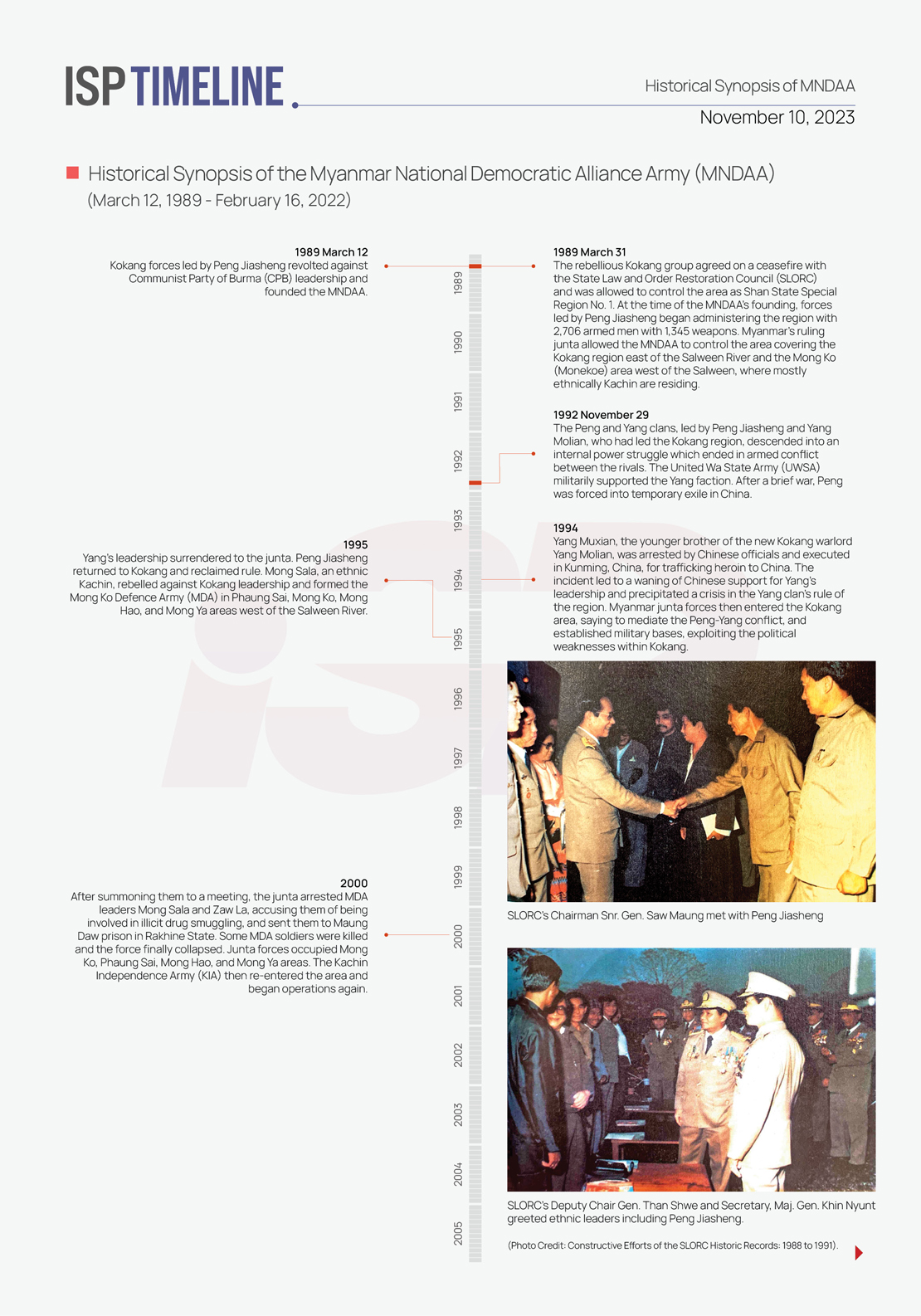
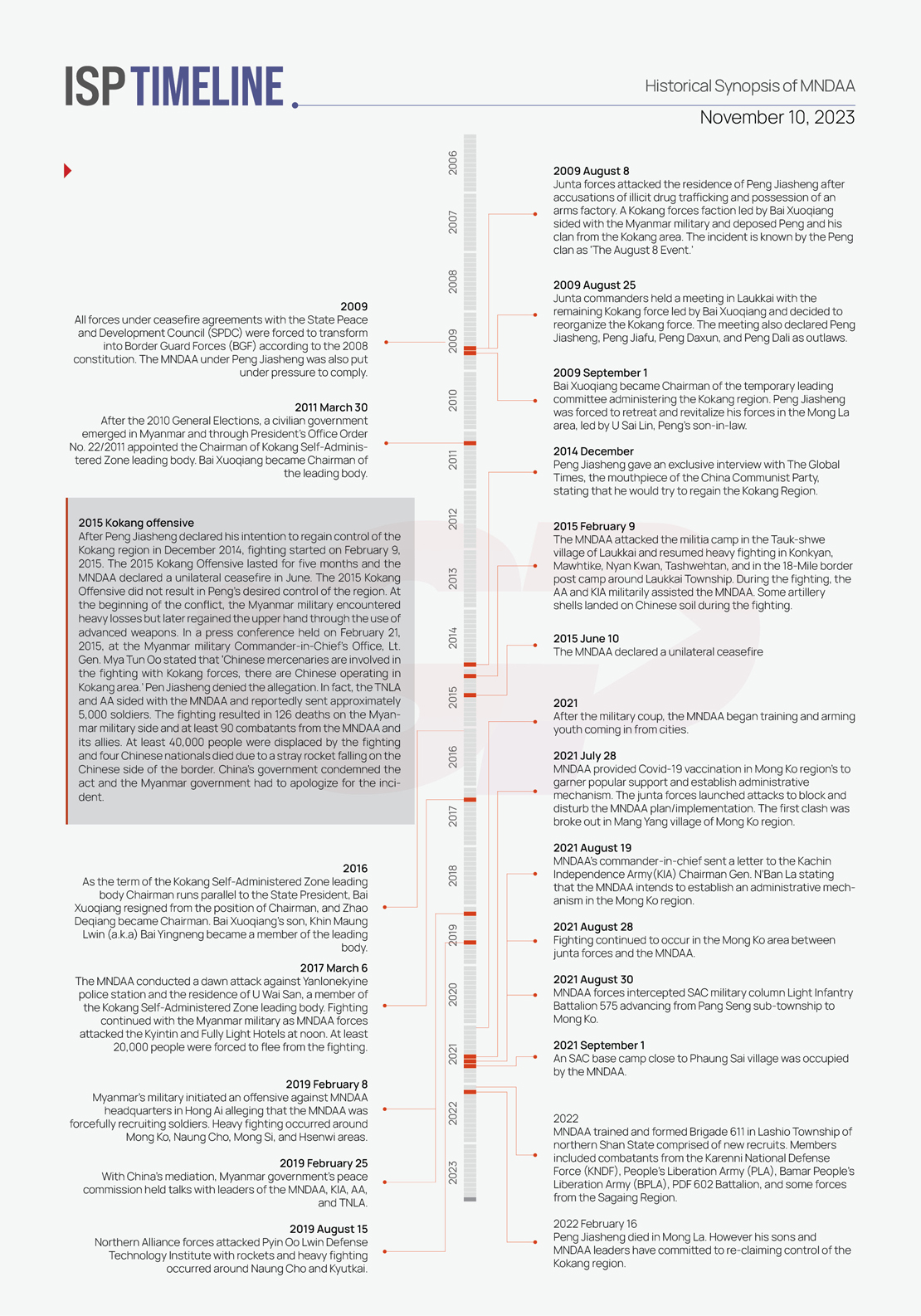
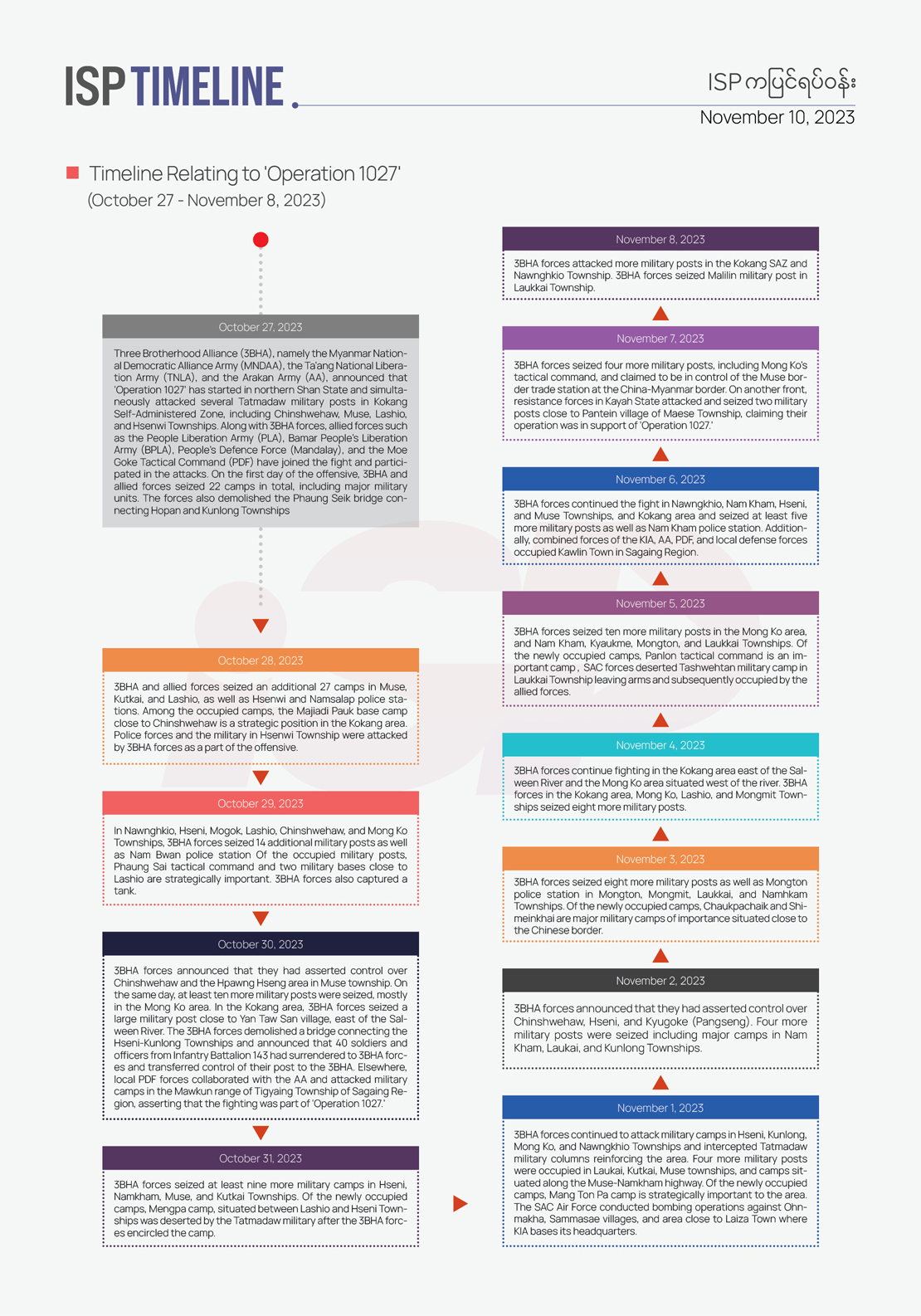
∎ What ISP is reading?
Karen Economic Committee and its Secretariat (KECS). (2023).
Karen Socio-Economic Household Survey (KSEHS). 38 pages.
The Karen National Union (KNU) published its first-ever ‘Multi-topic Household Survey’ report recently, coming in at just 38 pages. The KNU deserves appreciation for this effort. The survey was conducted by 73 enumerators along with some technical experts, with the collaboration of KNU leaders and district officials. The report mentions the study emphasizes eight thematic topics.
The survey was conducted between November 2022 and March 2023 (four months) and was led by the Karen Socio-Economic Household Survey (KSEHS) team and secretariat. The report does not necessarily cover the areas where Karen nationals are currently residing nor does it cover the entirety of the present geographical area of Karen (Kayin) State. The report does cover what they call ‘Kawthoolei,’ literally KNU controlled areas. This means that the report actually covers subjects in the geographic areas of the present Karen State, Mon State, and Tanintharyi Region.
The report describes there are 1.2 million people living in KNU-controlled areas (comprising more than 200,000 households). The present survey was conducted with 6,475 households. Among the respondents, 48.7 percent were male, and 51.3 percent were female. The survey results are compared with and reported alongside the ‘Myanmar Living Conditions Survey 2017’ (MLCS).
The survey report mentions that on average there are 5.4 persons living in each household, and that children and youth under the age of 20 constitute the largest portion of the population. However, the report highlights that the child mortality rate is currently the highest it has been in the past five years, possibly because of the Covid pandemic and subsequent consequences.
Ethnic demography of those residing in the survey area was broken down into 92 percent Karen, 4.5 percent Bamar, 1.1 percent Shan, 0.6 percent Mon, and 0.5 percent Pa-O. The survey covered areas from Karen State in the North to the Tanintharyi Region in the South, but the population ratio of this survey may reflect differently to regional data as the survey was conducted only in KNU-controlled areas. In terms of belief systems, 69.4 percent of respondents were Buddhists, while 25.1 percent were Christians, 3.7 percent were animists, 0.8 percent Muslims, and 0.9 percent were other believers.
On the question of disputes encountered at the community level, 98 percent of respondent households answered that there had not been a recent conflict. But among the two percent of respondents who answered ‘yes’, the conflicts were related to land disputes 31 percent, rumors and gossip 24 percent, drug/alcohol abuse 14 percent, and business issues nine percent.
In terms of respondents’ ownership, 98 percent (very high) owned housing, but 65 percent of the housing consisted of one bedroom or less than a room. It could be interpreted as either low quality housing or that houses are overcrowded. In terms of education, only 43 percent of children aged 18 or under had attained primary-level education, and 38 percent of respondents had ‘no education.’ Thirty-three percent of respondents answered that they cannot go to school due to conflict and security reasons. The survey results show a literacy rate of 71 percent (in at least one language). Fifty-eight percent of households answered that they owned land.
The survey was also looking at the situation of water and sanitation status. 42.7 percent of households used well water, while 30.1 percent used piped water and 13.1 percent used surface water. Eighty percent of respondents replied that they have pour-flushed toilets. In terms of technology and communication, 78.1 percent of households maintained at least one mobile phone in the family. However, access to electricity in the survey areas was low. Only 11.3 percent of households had access to electricity.
On household income, 4,259 respondents owned agricultural business, while 2,241 people earnd wages from employment, 2,121 respondents’ incomes came from their non-agricultural businesses, 1,382 people’s incomes came from international remittances, and 767 people received KNU support. According to the survey estimate, a household earns 1.5 million to three million Kyats annually. The report mentions that 35 percent of households are currently indebted. However, compared with the national level MLCS in 2017, the household indebted rate is still rather low. For health care in the community, 34 percent of respondents answered they have access to at least a health care center in the community.
The objective of conducting a socio-economic survey is to contribute empirical data that can be used in times of policy decision-making. Such data and evidence are also crucial in times of humanitarian assistance. The SAC is also planning its own National Census in 2024. Nevertheless, the effort put in to this survey and the systematic collection of data in Karen areas is worthy of support and we should take note of its significance.
1 In ‘Operation 1027’, along with 3BHA forces, the People’s Liberation Army (PLA) (Myanmar), Bamar People’s Liberation Army (BPLA), People’s Defence Force (Mandalay), and Moe Goke Tactical Command PDF forces are all collaborating with the 3BHA in the military operation.
2 Editor’s note: Since the publication of this OnPoint No. 17 Burmese version, Arakan Army (AA) initiated offensive attacks against SAC forces in many townships of Rakhine State on Nov 13, 2023.
To receive ISP Insight Emails in your inbox, subscribe at this link.

